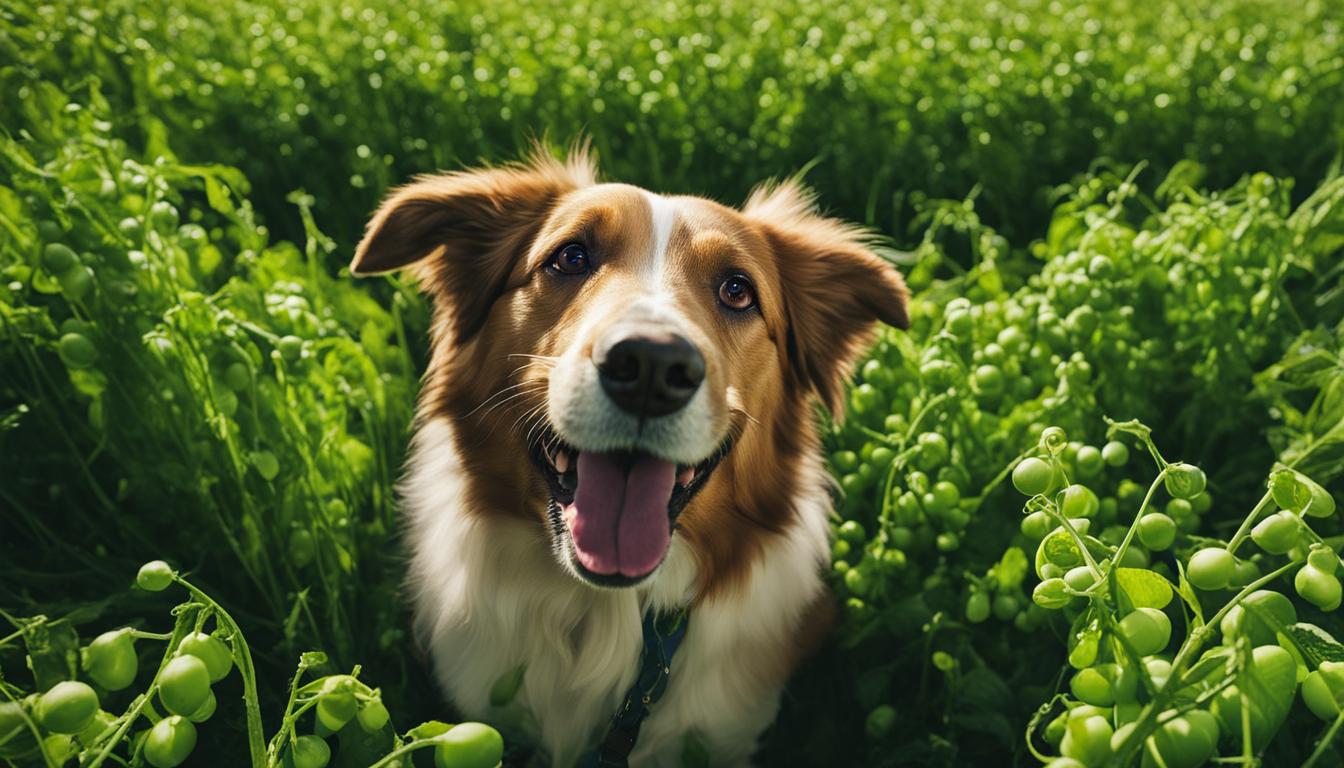As an Amazon Associate I earn from qualifying purchases.
Picture this: you’re sitting outside on a warm summer day, enjoying a delicious bowl of peas, and your loyal furry friend is sitting by your side, gazing at you with those irresistibly adorable eyes. Is it safe to share some peas with your canine companion? Can dogs eat peas without any worries?
As a pet owner, you want to make sure that your dog is not only happy but also healthy. It’s only natural to wonder if peas are a safe and nutritious addition to your dog’s diet. Well, fret not, because we’re here to answer all your questions and put your mind at ease.
So, let’s dive right in and explore whether peas are a dog-friendly treat that deserves a spot in your pup’s bowl!
Key Takeaways:
- Dogs can safely eat peas and enjoy their nutritional benefits.
- Peas provide vitamins, minerals, protein, and fiber to support a dog’s overall health.
- It’s important to feed peas in moderation and avoid any harmful seasonings or ingredients.
- Always consult with your veterinarian before introducing peas or any new food into your dog’s diet.
- So, grab a bowl of peas and let your furry friend join in on the healthy snacking!
Are Peas Good for Dogs?
Peas are more than just a tiny green vegetable; they can be a nutritional powerhouse for your furry friend. Packed with essential vitamins and minerals, peas offer a range of benefits that contribute to your dog’s overall health and well-being.
When it comes to nutritional value, peas are a standout. They are rich in vitamins A, K, and C, which support your dog’s immune system and promote healthy vision, blood clotting, and collagen production. Peas also provide vital minerals like iron and potassium, playing a key role in maintaining proper bodily functions.
Beyond their vitamin and mineral content, peas offer protein and fiber, making them an excellent addition to your dog’s diet. Protein is essential for muscle development and growth, while fiber aids in digestion and promotes regular bowel movements.
But that’s not all—peas are also a source of antioxidants, which help combat inflammation and protect your dog’s cells from damage. As your furry companion ages, these antioxidants can play a crucial role in supporting their joint health and reducing the risk of age-related diseases.
“Peas are not just a tasty treat for dogs, but they also provide a range of essential nutrients that can contribute to their overall health and well-being.”
In fact, many commercial dog foods include peas as an ingredient, highlighting their nutritional value and benefit to dogs. However, it is essential to consult with your veterinarian before making any significant dietary changes, especially if your dog has specific health conditions or sensitivities.
Peas in Commercial Dog Foods
Many pet food companies recognize the nutritional benefits of peas and incorporate them into their formulations. Peas can serve as a natural source of protein, fiber, and essential vitamins and minerals in dog food recipes. They provide a wholesome alternative to other filler ingredients, offering a nutrient-dense option for your furry friend.
| Benefit | Explanation |
|---|---|
| Rich in vitamins and minerals | Peas provide vitamins A, K, and C, as well as minerals like iron and potassium |
| Source of protein and fiber | Peas offer essential protein and fiber, promoting muscle development, digestion, and bowel regularity |
| Contain antioxidants | Peas are packed with antioxidants that reduce inflammation and protect cells from damage |
While peas can be beneficial for most dogs, it’s crucial to remember that every dog is unique. Working with a veterinarian ensures you make informed decisions about your pet’s diet and tailor it to their specific needs.
What Kinds of Peas Can Dogs Eat?
Dogs can enjoy a variety of peas, but it’s important to know which ones are safe and beneficial for them. Here’s a breakdown of the different types of peas that can be included in your dog’s diet:
- Frozen Peas for Dogs:
Frozen peas are a convenient and nutritious option for dogs. They should be plain, without any added seasonings or harmful ingredients. You can serve frozen peas as a tasty treat straight from the freezer, or cook them lightly for easier chewing. Frozen peas retain their nutritional value and offer a crunchy texture that dogs enjoy.
- Canned Peas for Dogs:
While frozen peas are a great option, canned peas are not recommended for dogs. These typically contain high levels of sodium, which can be harmful to their health. The added salt and preservatives in canned peas can lead to dehydration and other related issues. It’s best to avoid canned peas and opt for fresh or frozen alternatives.
- Chickpeas and Black-Eyed Peas for Dogs:
Chickpeas and black-eyed peas are legumes that can be safely fed to dogs. However, it’s crucial to cook them plain and without any spices or seasonings. These peas offer a good source of protein and fiber for your furry friend. They can be included in homemade meals or mixed with their regular dog food to add variety.
- Snap Peas for Dogs:
Snap peas, also known as sugar snap peas, can be a delightful addition to your dog’s diet. They can be served cooked or chopped into small pieces to aid digestion. Snap peas provide a satisfying crunch and are rich in vitamins and minerals, offering a refreshing taste for your canine companion.
Remember to introduce these peas gradually into your dog’s diet and monitor their response. If you notice any digestive upset or allergic reactions, consult your veterinarian for guidance. Now that you know the different types of peas that are safe for dogs, you can incorporate them into their meals and provide them with a nutritious treat.
How Many Peas Can Dogs Eat?
Feeding your furry friend peas can be a nutritious and tasty treat. However, it’s important to remember that moderation is key to ensure your dog’s digestive health. As a general rule of thumb, treats like peas should only account for about 10% of your dog’s overall calorie intake, with the remaining 90% coming from a balanced diet of dog food.
The recommended portion sizes of peas for dogs vary depending on their weight. For smaller dogs, such as those weighing around 10 pounds, 1 teaspoon of peas per day is usually sufficient. Medium-sized dogs, weighing around 30 pounds, can have up to 1 tablespoon of peas per day. Larger dogs, weighing around 60 pounds or more, can enjoy up to 3 tablespoons of peas per day.
However, it’s important to note that these are general guidelines. Every dog is unique, and factors such as age, activity level, and overall health should be taken into consideration when determining the appropriate portion size.
Consulting with a veterinarian is crucial to ensure you’re feeding your dog the right amount of peas. They can provide personalized advice based on your dog’s specific needs and help you avoid any potential issues.
Too many peas can lead to digestive upset, such as gas or bloating, in some dogs. By following the recommended portions and consulting with your vet, you can ensure that your dog enjoys the benefits of peas without any negative side effects.
Remember, dogs should always have a well-balanced diet that meets their nutritional needs. Peas should be seen as a supplement or occasional treat, rather than a replacement for a nutritious dog food.
Now that you know the appropriate portion sizes for feeding peas to dogs, let’s move on to the conclusion where we’ll recap the benefits of incorporating peas into your dog’s diet!
Conclusion
So, can dogs eat peas? Absolutely! These little green powerhouses can make for healthy snacks for dogs when given in moderation. Packed with essential vitamins, minerals, protein, and fiber, peas offer a range of nutritional benefits for your furry friend.
Feeding dogs peas can support their overall health, aid in digestion, and boost their immune system. However, it’s crucial to feed plain peas without any harmful ingredients. Avoid seasoning peas with salt, spices, or additives that may be harmful to dogs.
Before making any dietary changes or introducing new food into your dog’s diet, consult with a veterinarian. They can provide personalized guidance based on your dog’s individual needs, such as portion sizes, potential allergies, or existing health conditions. Your vet will help ensure that feeding peas to your dog remains safe and beneficial.
By following these guidelines, you can provide your four-legged companion with a tasty and nutritious snack while prioritizing their well-being. So go ahead and share some healthy peas with your pup and watch them enjoy the benefits of this nutritious treat!
FAQ
Can dogs eat peas?
Are peas good for dogs?
What kinds of peas can dogs eat?
How many peas can dogs eat?
Can dogs eat other types of peas?
Are peas a healthy snack for dogs?
Are there any dangers in feeding peas to dogs?
Source Links
- https://www.petmd.com/dog/nutrition/can-dogs-eat-peas
- https://spotpetins.com/blog/dog-tips/can-dogs-eat-peas
- https://www.akc.org/expert-advice/nutrition/can-dogs-eat-peas/
As an Amazon Associate I earn from qualifying purchases.

